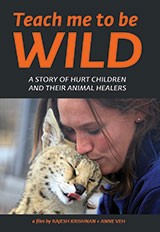
Teach Me To Be Wild: A Story of Hurt Children and their Animal Healers 2017
Distributed by Green Planet Films, PO Box 247, Corte Madera, CA 94976-0247; 415-377-5471
Produced by imageseers productions
Directed by Rajesh Krishnan and Anne Veh
Streaming, 59 mins
College - General Adult
Adolescents; Alternative Medicine; Animals
Date Entered: 08/21/2020
Reviewed by Brandon West, Social Sciences Librarian, State University of New York at GeneseoDirectors Krishnan and Vey explore how at-risk teenagers connect with injured animals to heal mentally and spiritually in this documentary. The teenagers are participating in a therapeutic program at Wildlife Associates, a non-releasable wild animal sanctuary in Northern California. This organization was founded by Steve Karlin, a man whose life’s work has centered on rescuing injured animals that range from horses to condors to sloths. The stories of the teens are interspersed throughout the film show how working with the animals helps them process complex issues such as suicidal ideation, anger, and authority issues.
The film begins with the narrative about a boy named Marvin, who exhibited suicidal ideation. He finds a connection with a condor who had suffered a permanent injury to a wing. Marvin explains that the condor, like him, is sad, hurt, and lonely. His ability to relate with the animal allow Marvin to process his own feelings in a way that was not achievable through traditional interventions. His mother explains that Wildlife Associates saved her son’s life because nothing else was working. Many other children are featured throughout the film and have similar experiences as Marvin: they find solace in caring for the animals, who become their personal confidants. A common theme offered by the teenagers is that the animals are non-judgmental and understand their pain; they are unable to make these connections with the people in their lives. This message is also echoed by Karlin, whose empathy for suffering animals drew him into this work.
The overall tone of the film is hopeful and uplifting. The passion that Karlin and his staff put into their work is inspiring especially when you witness the positive impact it has on the children. While it seems undeniable this type of alternative therapy can be effective, the film does not offer reasoning for why it works beyond the spiritual power of nature. While there might be some truth to this idea, it would have been nice to learn about some of the scientific rationale behind this type of intervention. Regardless, it posits an interesting approach to helping young people needing guidance, and perhaps educators or health care workers would be interested in this type of intervention. This film that is best suited for libraries supporting the curriculums of education, mental health programs, social work, or zoology programs.